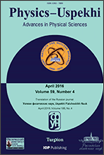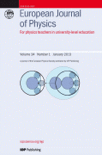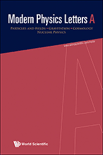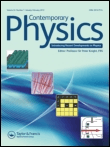
European Physical Journal Plus
Scope & Guideline
Empowering Research with Open Access to Knowledge
Introduction
Aims and Scopes
- Theoretical Physics:
Covers a wide range of topics including quantum mechanics, relativistic physics, cosmology, and statistical mechanics, with a focus on fundamental theories and their implications. - Computational Physics:
Emphasizes the development and application of computational methods to solve complex physical problems, including simulations in different physical contexts. - Experimental Physics:
Features studies that present novel experimental techniques or significant experimental results in various fields such as condensed matter physics, particle physics, and astrophysics. - Nanotechnology and Materials Science:
Explores the properties and applications of materials at the nanoscale, including the synthesis, characterization, and innovative uses of nanomaterials. - Biophysics and Medical Physics:
Includes research at the interface of physics and biology/medicine, focusing on the physical principles underlying biological processes and medical applications. - Astrophysics and Cosmology:
Investigates the physical universe, including the study of celestial bodies, cosmological models, and the fundamental laws governing the universe. - Interdisciplinary Research:
Encourages studies that combine physics with other disciplines such as chemistry, biology, and engineering, fostering collaborative approaches to solve complex scientific questions.
Trending and Emerging
- Quantum Computing and Information:
Research in quantum computing and information theory is gaining momentum, with studies focusing on quantum algorithms, quantum entanglement, and applications of quantum mechanics in computing. - Machine Learning in Physics:
The integration of machine learning techniques in physics research is becoming increasingly prevalent, particularly in data analysis, predictive modeling, and simulations. - Complex Systems and Networks:
There is a growing interest in the study of complex systems, including the dynamics of networks, ecological models, and the behavior of systems with many interacting components. - Environmental Physics and Sustainability:
Research addressing climate change, renewable energy, and the environmental impact of physical systems is on the rise, reflecting a societal push towards sustainability. - Topological Materials and Quantum States:
The exploration of topological materials and their unique properties, including topological insulators and quantum states, is emerging as a significant area of research. - Biophysics and Medical Applications:
The intersection of physics and biology is becoming more prominent, with a focus on biophysics, medical imaging, and the physical principles underlying biological processes.
Declining or Waning
- Classical Mechanics:
There has been a noticeable decline in publications focusing solely on classical mechanics, as the field has become more integrated with advanced topics such as quantum mechanics and relativistic physics. - Low-Energy Nuclear Physics:
Research in low-energy nuclear physics appears to be waning, possibly due to a shift of interest towards high-energy physics and astrophysical applications. - Traditional Material Science:
Studies that focus on traditional material properties without the incorporation of nanotechnology or advanced materials have seen less interest, as researchers are increasingly drawn to innovative materials with unique properties. - Simple Mathematical Models:
The use of simplistic mathematical models without significant complexity or real-world relevance has decreased, as there is a growing preference for models that incorporate more realistic conditions and variables.
Similar Journals

ACTA PHYSICA SINICA
Empowering Researchers with Groundbreaking InsightsACTA PHYSICA SINICA is a prominent journal published by the Chinese Physical Society, dedicated to the dissemination of groundbreaking research in the field of physics and astronomy. Established in 1993, this journal has consistently contributed to the scientific community by publishing high-quality articles that cover a wide range of topics within general physics and related disciplines. Although currently classified in Q4 of the physics and astronomy category by Scopus, ACTA PHYSICA SINICA plays an important role in fostering collaboration and communication among researchers in China and around the world. With a substantial readership, this journal is poised to remain a valuable resource for professionals, researchers, and students alike. By providing in-depth analysis and insights, it aims to advance the understanding and application of physical principles in various technological and scientific advancements. The journal is accessible via subscription, ensuring that contributors and readers can engage with the evolving landscape of physics research. For more information, visit the publisher's website.

Jurnal Fizik Malaysia
Connecting Minds, Expanding Horizons in Physics Research.Jurnal Fizik Malaysia is a prominent academic journal dedicated to advancing the field of physics, published by the esteemed Institut Fizik Malaysia. With an aim to foster knowledge dissemination and research collaboration among physicists, the journal serves as a vital platform for original research articles, reviews, and technical notes that cover various sub-disciplines of physics. Although the journal operates under a traditional subscription model, its commitment to quality has been bolstered by a rigorous peer-review process, ensuring high academic standards. Researchers and students in Malaysia and beyond are encouraged to engage with this journal, contributing to a deeper understanding of physical sciences and its applications. Moreover, with its ISSN 0128-0333, Jurnal Fizik Malaysia continues to play a significant role in the scientific community, enhancing visibility and accessibility for local and international research outputs in the ever-evolving landscape of physics.

EUROPEAN PHYSICAL JOURNAL E
Fostering collaboration for groundbreaking scientific discoveries.EUROPEAN PHYSICAL JOURNAL E, published by Springer, is a vital platform for researchers and professionals in the multidisciplinary fields of Biophysics, Biotechnology, Chemistry, Materials Science, and Medicine. With a focus on innovative research and developments from 2000 to 2024, this journal not only contributes to advancing knowledge but also provides insights into a wide array of applications in scientific and industrial sectors. Although it does not currently offer open access, its rigorous peer-review process ensures high-quality publications. With a 2023 impact factor ranking it in the third quartile across various relevant categories, including Q2 in Chemistry (miscellaneous), it stands as a credible source for emerging researchers and established scientists alike. The journal aims to foster collaboration and interdisciplinary research, making it an essential resource for anyone interested in the latest advancements across these interconnected fields.

PHYSICS-USPEKHI
Elevating Peer-Reviewed Scholarship Since 1993PHYSICS-USPEKHI, published by Uspekhi Fizicheskikh Nauk, is a prominent peer-reviewed journal in the field of physics and astronomy, reaching researchers and professionals since its inception in 1993. With an ISSN of 1063-7869 and an E-ISSN of 1468-4780, this esteemed journal has been classified as Q2 in the Physics and Astronomy category based on the 2023 quartiles, ranking 74 out of 243 journals in its Scopus classification, placing it in the 69th percentile. Although currently not an open access journal, it provides invaluable insights and advancements in the field, fostering an environment for scholarly exchange and collaborative research. Based in Moscow, Russia, PHYSICS-USPEKHI continues to shape the landscape of theoretical and experimental physics, inviting submissions that contribute to its rich legacy of high-impact scientific discourse.

EUROPEAN JOURNAL OF PHYSICS
Driving Excellence in Physics ResearchEuropean Journal of Physics, published by IOP Publishing Ltd, is a premier international journal serving the diverse field of physics and astronomy. With a commitment to advancing scientific knowledge since its inception in 1980, the journal provides a platform for original research articles, reviews, and topical discussions in various domains, including theoretical and experimental physics. Operating out of the United Kingdom, the journal has achieved a commendable Q2 ranking in the Physics and Astronomy (miscellaneous) category for 2023, reflecting its robust influence in the academic community, alongside a notable Scopus Rank that underscores its relevance in both the Social Sciences and General Physics and Astronomy fields. Although it does not currently offer open access, the journal's traditional publication model ensures rigorous peer review, maintaining high scholarly standards that are imperative for researchers, professionals, and students striving to stay ahead in their respective fields. Don't miss the opportunity to engage with cutting-edge research and contribute to the ongoing dialogue in physics by accessing this vital resource.

Physics, published by MDPI, is an open-access journal that commenced in 2019 and has quickly established itself as a significant contributor to the field of physics and astronomy. With a respectable impact factor and categorized in the Q2 quartile for 2023, this journal serves a broad spectrum of topics within the discipline, fostering innovative research and insights. As part of the MDPI portfolio, known for promoting high-quality, peer-reviewed research, Physics aims to provide a platform for scholars, professionals, and students to publish their findings and engage with contemporary debates in the field. The journal's accessibility, paired with its commitment to scientific excellence, ensures that research is readily available to a global audience, which is crucial for advancing knowledge and collaboration in physics. Located in the heart of Switzerland at ST ALBAN-ANLAGE 66, CH-4052 BASEL, the journal enjoys a position at the nexus of cutting-edge research and academia.

MODERN PHYSICS LETTERS A
Exploring the Depths of Astrophysics and Nuclear PhysicsMODERN PHYSICS LETTERS A, published by World Scientific Publishing Co Pte Ltd, is a distinguished journal in the field of physics that serves as a pivotal platform for researchers, professionals, and students alike. With ISSN 0217-7323 and E-ISSN 1793-6632, the journal has gained international acclaim for its contributions to Astronomy and Astrophysics as well as Nuclear and High Energy Physics. The journal is ranked in Q3 for both Astronomy and Astrophysics and Nuclear and High Energy Physics, showcasing its relevance in these areas, while also achieving a Q2 ranking in the broader category of Physics and Astronomy (miscellaneous). Spanning from 1996 to 2024, MODERN PHYSICS LETTERS A promotes open dialogue and dissemination of pioneering research findings and innovative theories. While the journal operates without an open access option, its rich content is easily accessible through various academic databases, ensuring that vital research is shared widely among the scientific community. Situated in Singapore, this journal plays an essential role in the continuous advancement of the physics discipline, fostering collaboration and knowledge sharing among global researchers.

Frontiers of Physics
Pioneering Discoveries in the Realm of PhysicsFrontiers of Physics, published by Higher Education Press, is a premier open-access journal dedicated to fostering innovative research and excellence within the field of physics. With an ISSN of 2095-0462 and an E-ISSN of 2095-0470, this rapidly growing journal has established itself as a valuable platform for disseminating cutting-edge findings, covering a diverse range of topics from theoretical frameworks to experimental advancements. Notably, Frontiers of Physics has achieved an impressive Q1 ranking in the 2023 Scopus Quartiles for Physics and Astronomy, securing a competitive 5th out of 81 positions in its category, reflecting a high impact factor that underscores its importance to the scientific community. Since its inception in 2011 and continuing through 2024, the journal aims to bridge the gap between academia and industry, encouraging collaboration among researchers, professionals, and students alike. Its commitment to open access ensures that high-quality research is readily accessible, thereby promoting knowledge sharing and advancement in the global physics community. Explore the potential of your research in Frontiers of Physics, where the future of physics flourishes.

CONTEMPORARY PHYSICS
Illuminating Contemporary Discoveries in PhysicsCONTEMPORARY PHYSICS, published by Taylor & Francis Ltd, stands as a notable journal in the field of physics and astronomy, offering a comprehensive platform for the dissemination of cutting-edge research and developments since its inception in 1959. With an Impact Factor that reflects its solid position within the academic community, as evidenced by its Q2 ranking in the 2023 category of Physics and Astronomy (miscellaneous) and a Scopus Rank of 111 out of 243, this journal plays an essential role in bridging theoretical advances and practical applications. Researchers and professionals are encouraged to explore its diverse scope, which aims to foster innovative ideas and foster interdisciplinary collaboration. Although not currently an open access journal, CONTEMPORARY PHYSICS is committed to maintaining the highest standards of editorial excellence and provides valuable insights across converged eras of research from 1959 to 2024, making it indispensable for those dedicated to advancing their knowledge and contributions in the realm of physics.

Ukrainian Journal of Physics
Pioneering Research for Tomorrow's InnovationsUkrainian Journal of Physics, published by the Bogolyubov Institute for Theoretical Physics of the National Academy of Sciences of Ukraine, stands as a significant platform for the dissemination of research in the dynamic field of physics. With its ISSN 2071-0186 and E-ISSN 2071-0194, the journal aims to foster academic dialogue and innovation among researchers, professionals, and students alike. Recognized with a Scopus ranking that places it in the 26th percentile, the journal offers an array of contributions spanning various domains, including general physics and astronomy. Although currently categorized in the Q3 quartile for 2023, it seeks to elevate its scholarly impact while providing open access to its contents, facilitating wider availability and engagement. With a commitment to publishing high-quality research from 2007 to 2024, the journal embraces interdisciplinary approaches to physics, making it an invaluable resource for anyone dedicated to advancing their understanding and exploration of physical sciences.